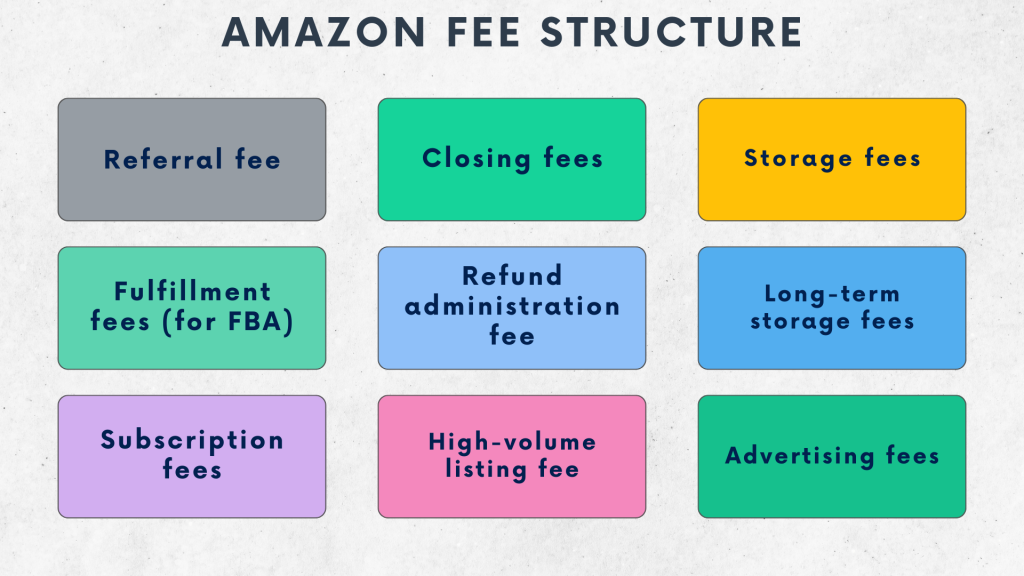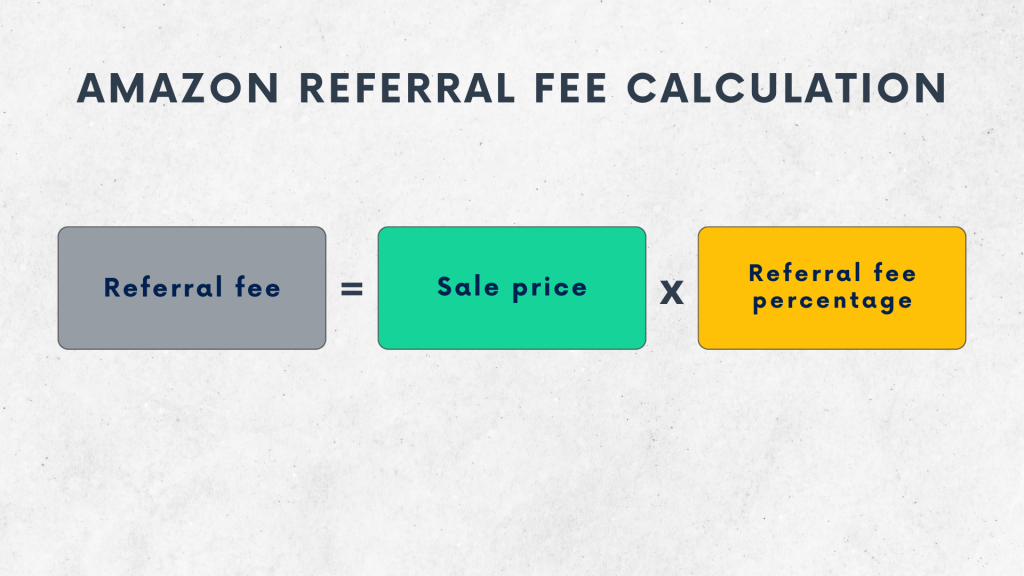Selling on Amazon is a significant part of many businesses, offering a vast market and benefits like an extended customer base and efficient logistics. However, Amazon’s services come with fees, and understanding these charges is critical for sellers to optimize profits. One essential fee is the referral fee, which Amazon charges for facilitating product sales.
So, let’s talk about referral fees, their nuances, and how sellers can potentially lower them.
Amazon seller fees and charges a shopkeeper might face
Let’s start with the basics and look at Amazon’s fee structure.
Amazon’s seller fees are charges sellers pay for utilizing the platform’s services to list, sell, and fulfill their products. These fees encompass the referral fee, fulfillment fees (if using Amazon’s fulfillment services), subscription fees for several seller plans, and other optional service fees.
Understanding and managing these fees helps sellers optimize their profitability and make the most of selling on the Amazon marketplace.
Let’s break down Amazon seller fees real quick.

Referral fee
A percentage of the item’s sale price, typically ranging from 5% to 45% depending on the product category. There is also a minimum fee of $0.30 per item sold.
Fulfillment fees (for FBA)
Charges sellers face using Fulfillment by Amazon (FBA) for storage, packing, and shipping. The fees vary based on the size and weight of the item.
Subscription fees
Amazon offers two selling plans – Individual and Professional. Individual sellers pay a per-item fee for each sale. On the other hand, Professional sellers pay a monthly subscription fee, gaining access to additional features and lower per-item selling fees.
Closing fees
Applicable to several categories (e.g., books, DVDs), these fees cover the cost of selling within those categories.
Refund administration fee
The fees might apply to the seller who failed to follow the refund policy or if a refund for a return is not issued.
High-volume listing fee
Amazon might charge a monthly fee for sellers with multiple active non-media listings.
Storage fees
Storage fees are the fees that sellers storing products in Amazon’s fulfillment centers pay based on the volume of space occupied.
Long-term storage fees
They usually apply when a seller’s products remain in Amazon’s fulfillment centers for an extended period.
Advertising fees
Sellers using Amazon’s advertising services, such as Sponsored Products or Display Ads, incur fees based on their advertising spend.
As you can see, there are plenty of fees. But you do not necessarily have to pay for all of them. Many depend on what you sell and which Amazon services you use to run your ecommerce business.
If you select selling on Amazon, you might want to account for Amazon fees accurately. Amazon integration with accounting can help automatically import and categorize your business transactions into accounting, including sales, fees, taxes, and more. So you can always have accurate financial reporting, smooth reconciliation, and facilitated tax prep.
Book your free seat at Synder’s weekly webinar to learn how it can handle your ecommerce accounting. You might as well jump on signing up for a free 15-day trial and see all the amazing stuff Synder has for you under the hood.
What is a referral fee, and how to calculat it?
Now, we can proceed with the referral fee.
Amazon’s referral fee is a fee that sellers pay for utilizing the platform to sell their products. Unlike a transaction fee that Amazon takes for processing payments, this fee is what you pay for selling through the platform. It’s calculated as a percentage of the item’s sale price and goes with each sale made through the platform.
Amazon’s referral fees are integral to the services the platform provides to sellers. These fees contribute to maintaining the expansive Amazon marketplace, ensuring secure payment processing, and supporting the infrastructure that enables seamless transactions. Essentially, sellers pay these fees for access to Amazon’s massive customer base and the convenience of leveraging the platform’s well-established ecommerce ecosystem.
The referral fee structure typically ranges from 5% to 45% of the item’s sale price, depending on the product category. It’s important to note that there is also a minimum fee of $0.30 per item, ensuring that even low-priced items contribute to the overall cost structure.
Understanding Amazon product categories for sellers
The percentage breakdown reflects the varying costs associated with different product categories. For instance, electronics and high-tech gadgets usually fall at the upper end of the range, while categories like books or clothing tend to have lower referral fees. Sellers must delve into the specific fee structures for their product categories, as the fees that sellers see on their end might differ from what customers observe. This difference is because customers generally see the total price, including the referral fee, while sellers know the deducted fee.
Clearly understanding your product category and its associated fees ensures accurate calculations. Regularly reviewing Amazon’s fee schedule is advisable, as fee structures can change, impacting your overall costs on the platform.
How to calculate your fee?
Calculating your referral fee on Amazon involves a straightforward process. The fee is a percentage of the item’s sale price, with some categories having a minimum fee per item. Here’s how you do it, step-by-step.

- Step #1 – Determine your product category
Identify the specific category to which your product belongs. Different categories on Amazon have varying fee percentages.
- Step #2 – Know the sale price
Determine the sale price of your product. It’s the amount for which you are selling the item on Amazon.
- Step #3 – Check the referral fee percentage
Refer to Amazon’s fee schedule to find the referral fee percentage for your product category. As mentioned, it can be anything within the 5-45% range.
- Step #4 – Calculate the referral fee
Multiply the sale price of your item by the referral fee percentage. For example, if your product falls under a category with a referral fee of 15% and costs $20, the referral fee would be $20 * 0.15 = $3.00.
- Step #5 – Consider the minimum fee (if applicable)
Be aware of any minimum referral fees for your category (some categories go without them, but the majority have a minimal fee). If your calculated referral fee is less than the minimum fee, Amazon will charge you the minimum fee instead.
- Step #6 – Final calculation
Compare the calculated referral fee and the minimum fee (if applicable). The higher of the two will be your actual referral fee for that sale.
Finally, here’s a simplified formula to calculate the referral fee.
Referral Fee = Sale Price × Referral Fee Percentage
How do referral fees impact a seller’s overall profitability?
Referral fees impact a seller’s overall profitability substantially, so you might want to carefully consider them within the broader context of an Amazon business strategy. Here’s a more detailed exploration of how referral fees influence a seller’s bottom line:
#1 – Cost-benefit analysis
Sellers need to conduct a comprehensive cost-benefit analysis to understand the impact of referral fees on their overall profitability. While referral fees represent a direct cost, the benefits derived from access to Amazon’s massive customer base, reliable payment processing, and fulfillment infrastructure can lead to increased sales volume and visibility. Sellers should weigh these benefits against the incurred costs to evaluate the net impact on their bottom line.
#2 – Competitive pricing strategy
Accurate calculation and strategic incorporation of referral fees into product pricing are essential for maintaining a competitive edge. Sellers can’t ignore the market dynamics and customer expectations as they determine their pricing strategy. It can help them attract more customers and potentially offset the impact of referral fees through increased sales.
#3 – Optimizing profit margins
Sellers must balance setting prices that appeal to customers and ensuring their profit margins remain healthy. Careful consideration of fixed and variable costs, including referral fees, allows sellers to establish pricing to cover expenses and provide room for sustainable profitability. This strategic approach is crucial for the long-term success of one’s Amazon business.
#4 – Utilizing Fulfillment by Amazon (FBA)
Sellers leveraging Amazon’s FBA program should factor in the associated referral and fulfillment fees. While FBA provides operational advantages, the combined impact of these fees influences the overall cost structure. However, the convenience of FBA can lead to increased sales and customer satisfaction, further impacting a seller’s profitability equation.
#5 – Strategic marketing and promotion
Sellers can use marketing and promotional strategies to maximize the benefits of being on the Amazon platform. It might include participating in Amazon’s advertising programs, running promotions, or offering bundled deals. Such initiatives can contribute to increased sales, potentially mitigating the impact of referral fees on overall profitability.
What impacts the final price for customers? Wrap, shipping, and more
We’ve just mentioned how referral fees and FBA fees can be factored into the price of products on Amazon. Other factors can impact the final price, greater or less, and sellers should consider these elements when setting their product prices (as they affect their profitability directly).
Let’s break them down.
Shipping costs
The cost of shipping is a significant factor in the final price. Sellers using FBA benefit from Amazon’s shipping infrastructure, but those handling shipping themselves must account for postage (the prices for sending small or large standard packages differ), packaging materials, and related expenses. These costs can influence the final price for customers.
Gift wrap and other services
Sellers offering additional services, such as gift wrap service or expedited shipping, may include these costs in the final price. These extra services can enhance the customer experience but contribute to the overall cost structure for the seller.
Promotions and discounts
Sellers may choose to run promotions or offer discounts, impacting the final price for customers. While these strategies can boost sales, sellers need to ensure that the discounted prices still cover all associated costs, including referral fees and other fees.
Taxes and import fees
Taxes (like sales tax) and import fees may apply depending on the product and the seller’s location. Sellers should provide for these additional costs in the pricing strategy to avoid surprises for them and their customers.
Wrapping it up, sellers’ profitability on Amazon combines providing for various components. Think of fees, costs, competitive dynamics, etc. Sellers might want to carefully calculate and consider all these factors to set customer-wise prices while ensuring their business remains profitable and sustainable.
Are there ways to lower fees for selling on Amazon?
Sellers have various strategies to potentially lower Amazon referral fees.
Enrolling in Amazon’s FBA program streamlines logistics and can lower referral fees for certain products. FBA efficiently handles storage, order fulfillment, and customer service, freeing up sellers to focus on business growth. This program enhances a product’s competitiveness and may attract more customers, potentially boosting sales.
High-volume sellers on Amazon, with their substantial sales and positive customer feedback, often have the opportunity to negotiate fees with the platform. Negotiations can lead to more favorable fee structures, enhancing efficiency and profitability. While the extent of negotiation possibilities may vary, establishing a collaborative relationship with Amazon benefits both parties and allows sellers to optimize their financial performance.
Additionally, taking advantage of promotional programs and discounts offered by Amazon can be a viable strategy to optimize costs.
Bottom line
As you can see, recognizing Amazon’s referral fees is vital for sellers aiming to enhance profits. Strategically enrolling in FBA, negotiating fees as a high-volume seller, and utilizing promotional programs can help sellers align pricing strategies with the online market dynamics, ensuring competitiveness and sustained financial success on Seller Central.
It’s important to note that referral fees – standard fees for Amazon – significantly impact a seller’s overall earnings. Thus, factoring them into the total sales price calculation is crucial for securing a lucrative position in the marketplace.
Sharing is caring
Are you selling on Amazon? Share your experience with handling referral fees in the comment section below.











.png)